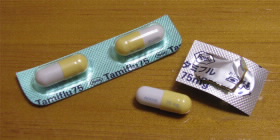FOR IMMEDIATE RELEASE
ACS News Service Weekly PressPac: January 13, 2010
Toward a less expensive version of the anti-flu drug Tamiflu
Scientists have developed an alternative method for producing the active ingredient in Tamiflu®, the mainstay for fighting H1N1 and other forms of influenza. The new process could expand availability of the drug by reducing its cost, which now retails for as about $8 per dose. Their study is in ACS’ Organic Letters, a bi-weekly journal: “Efficient Formal Synthesis of Oseltamivir Phosphate (Tamiflu) with Inexpensive D-Ribose as the Starting Material.”
Anqi Chen, Christina Chai and colleagues note that the global pandemic of H1N1 has resulted in millions of infected cases worldwide and nearly 10,000 deaths to date. Tamiflu®, also known as oseltamivir phosphate, remains the most widely used antiviral drug for the prevention and treatment of H1N1 infections as well as bird flu and seasonal influenzas. But growing demand for the drug has put pressure on the supply of shikimic acid, the raw material now used in making the drug. “As a result, chemists worldwide including ourselves have explored the possibility of using other alternative raw materials for the synthesis of the drug” said Chen and Chai, who led the research.
The scientists describe a new process for making the drug that does not use shikimic acid. They found that D-ribose, a naturally-occurring sugar produced by fermentation in large scales, potentially provides an inexpensive and abundant source of starting material for making the drug. D-ribose costs only about one-sixth as much as shikimic acid. In lab studies, the scientists demonstrated the potential use of D-ribose as an alternative source for the synthesis of Tamiflu®.
![]()
Contact
Science Inquiries: Michael Woods, Editor, 202-872-6293
General Inquiries: Michael Bernstein, 202-872-6042

Credit: Vantey, Wikimedia Commons
(High-resolution version)

